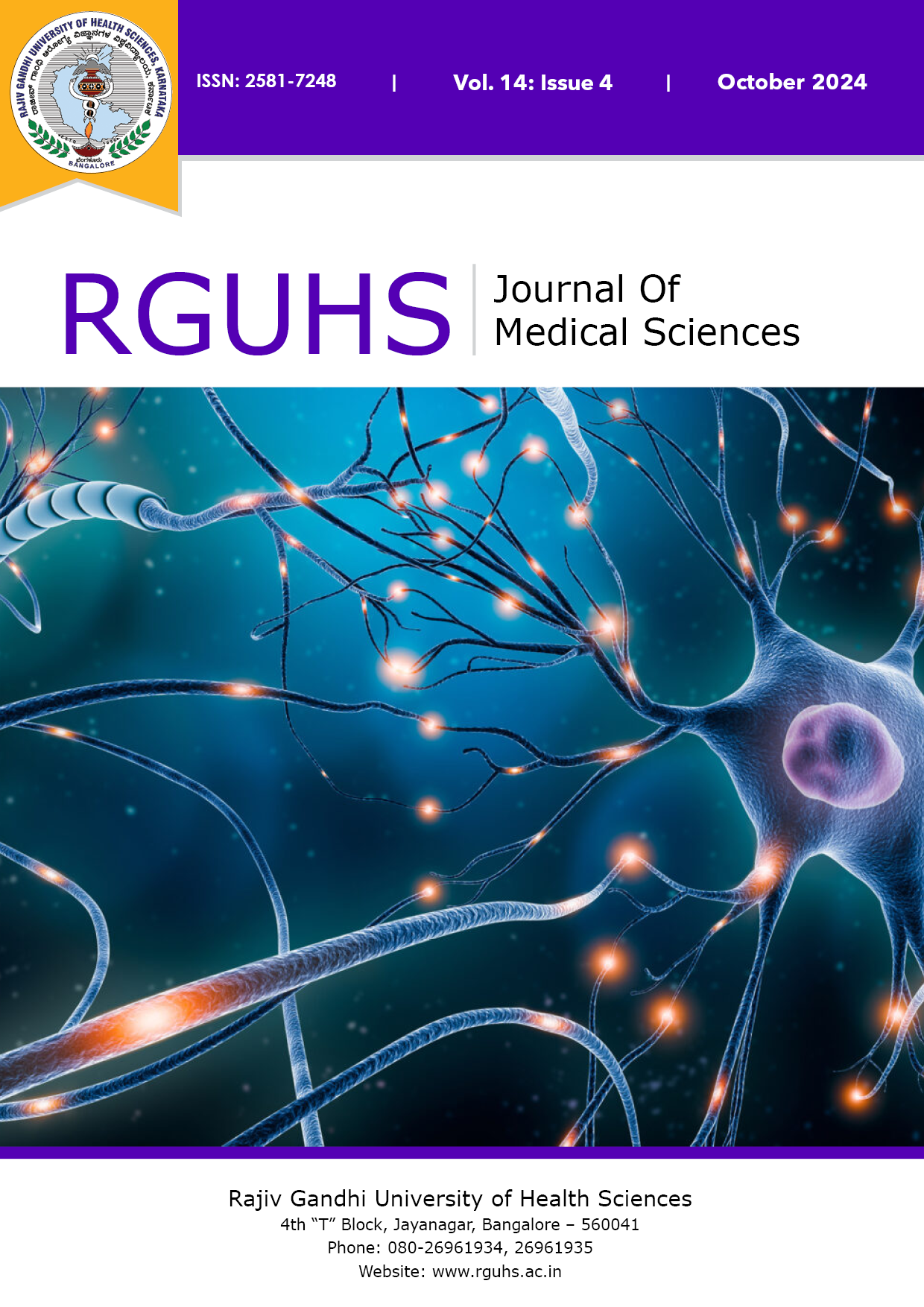
Abbreviation: RJMS Vol: 15 Issue: 1 eISSN: 2581-7248 pISSN 2231-1947
Dear Authors,
We invite you to watch this comprehensive video guide on the process of submitting your article online. This video will provide you with step-by-step instructions to ensure a smooth and successful submission.
Thank you for your attention and cooperation.
A Case report of ischaemic infarct secondary to vitamin B 12 deficiency induced hyperhomocystenaemia
Sangram Biradar1, Rishika Reddy2, Sumangala Soogareddy3
1Professor of Medicine,
2-3Post Graduate,
Department of General Medicine, MahadevappaRampure Medical College, Kalaburagi.
*Address of Correspondence:
Dr.Rishika Reddy, H.No 1-949/73/112,Sadashiv Nagar, Old Jewargi Road, Kalaburagi, Karnataka-585102 reddy.rishi25@gmail.com

Abstract
A 29 year old male presented with complaints of giddiness,swaying to right side and numbness in left upper limb and lower limb since 15days, There was one episode of seizure with a apost ictal confusion and diplopia. Magnetic resonance imaging (MRI) showed acute infarct in right posterior parietal cortex and subcortical white matter and right centrum semiovale. Magnetic resonance angiography (MRA) showed hypoplastic right anterior communicating artery (ACA). Serum homocysteine levels were elevated and serum Vitamin B12 levels reduced.
Stroke caused by hyperhomocysteinemia secondary to vitamin B12 deficiency is rare and preventable cause of ischaemic stroke.
Keywords
Downloads
-
1FullTextPDF
Article
Introduction
Epidemiological research has shown that increased total homocysteine (tHcy) levels are associated with an increased risk of thromboembolic disease; however, controversy still exists over which subtype of stroke is allied to hyperhomocysteinemia. Stroke caused by hyperhomocysteinemia secondary to vitamin B12 deficiency is rare and is a preventable cause of ischaemic stroke.
Case report
A 29year old right handed male presented to Basaweshvar hospital casualty at 9.30 pm on 14/02/18 with complaints of giddines and swaying to right side since 15 days, numbness in left upper limb since 15 days, and history of one episode of seizure at 7 pm on the day of presentation to the hospital. Generalised tonic clonic seizure (GTCS) associated with uprolling of eyes followed by altered sensorium. There was no fever,headache, or vomiting. No history of deviation of angle of mouth,nasal regurgitation, or dysphagia. There was history of diplopia and blurring of vision. Patient was a smoker since 5years, smoking 10 cigarettes /day. He was in the habit of consuming alcohol twice a week. There was no significant past history of any co morbidities, no significant family history of similar complains.
On examination patient was in altered sensorium, BP:100/70mmHg ;PR:86bpm;CNS examination revealed,pupilb/l equal and reactive,power 4/5 in left upper limb and lower limb, Deep tendon reflexes in left upper limb and lower limb 3+, Plantars showed a flexor response.MRI T2/FLAIR images revealed acute infarct in right peritrigonal area, right posterior parietal cortex and subcortical white matter and centrum semiovale. MRA showing hypoplastic A1 segment of right ACA; MRV (Magnetic Resonance Venogram) was normal.
A diagnosis of acute infarct was made. To find out the underlying etiology all relevant investigations (Complete Blood picture, Erythrocyte sedimentation rate, Renal function Test, antiphospholipid antibody, Protein C, Protein S, antithrombin III, serum homocysteine, prothrombin time, aPTT-activated partial thromboplastic time, serum Vitamin B12 levels) were done. All investigations were normal except serum Vitamin B12 which was reduced (158 pg/ mL; N: 211-911pg/ml) and serum homocysteine level was moderately elevated (52.25micromol/L ; N : <12micromol/L).
Patient was treated with low molecular weight heparin for 5 days, vitamin B12 supplements. Patient was discharged with vitamin B 12and folic acid supplements with clopidogrel and atorvastatin. Repeat MRI with MRA was done which showed gliosis due to old parenchymal insult in right centrum semiovale, MRA was normal.
Discussion
Stroke is a heterogeneous condition and its subtypes have different pathophysiological mechanisms and etiologies. Despite a gradual decline in overall stroke death rates in many industrialized countries, stroke remains a leading cause of death and disability in the world1 Homocysteine (Hcy) is a four-carbon amino acid with a free thiol group, which is formed by demethylation of methionine, an essential amino acid derived from diet. Normal total Hcy (tHcy) concentrations ranges from 5-15 μmol/L in the fasting state.
Hyperhomocysteinemia (HHcy) has been classified into moderate (plasma tHcy concentrations of 15-30 μmol/L), intermediate (plasma tHcy concentrations of 31-100 μmol/L), and severe (plasma tHcy concentrations 100 μmol/L).2 Both acquired and genetic factors can have an impact on plasma tHcy. An independent and dose-related relationship between elevated total homocysteine (tHcy) and atherosclerotic diseases has been demonstrated by multiple studies.
Elevated serum level of homocysteine is a well accepted risk factor for ischaemic stroke and IHD.No randomized trial has so far shown that lowering tHcy reduces the prevalence of cerebral ischemicevents.3 Boushey et al demonstrated that the administration of folate, vitamin B12, and vitamin B6 decreased Hcy.4
Furthermore, Biswas et. al reported that taking 5 mg folate decreased Hcy significantly.5 However, large randomized trials are needed to determine whether decreased tHcy levels by multivitamin therapy can reduce the risk of cardiovascular disease. If a combination of vitamins is found to be effective, this safe, inexpensive, easily administered therapy will probably be widely used throughout the world and have a major effect on public health.
Supporting File
References
- Biller J, Love BB, Schneck MJ. Vascular Diseases of the Nervous System. In: BradlyWG, Daroff RB, editors. Neurology in Clinical Practice. 5th ed. Philadelphia: Butterworth- Heinemann; 2008. p. 1165.Google Scholar
- Christopher R, Nagaraja D, Shankar SK. Homocysteine and cerebral stroke in developing countries. Curr Med Chem. 2007;14:2393-401.Google Scholar
- A, Del Zotto E, Padovani A. Homocysteine and cerebral ischemia: pathogenic and therapeutical implications. Curr Med Chem. 2007;14:249-63.Google Scholar
- Boushey CJ, Beresford SA, Omenn GS, Motulsky AG. A quantitative assessment of plasma homocysteine as a risk factor for vascular disease. Probable benefits of increasing folic acid intakes. JAMA. 1995;274:1049-57.Google Scholar
- Biswas A, Ranjan R, Meena A, Akhter MS, Yadav BK, Munisamy M, et al. Homocystinelevels, polymorphisms and the risk of ischemic stroke in young Asian Indians. J Stroke Cerebrovasc Dis. 2009;18:103-10. Google Scholar

